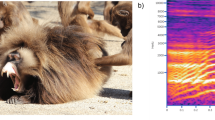Abstract
Research suggests that auditory environmental enrichment might reduce abnormal behavior in certain primate species. The authors evaluated the behavioral effects of exposure to music in a prosimian primate (Garnett's bushbaby; Otolemur garnettii). They exposed bushbabies to a Mozart concerto for 15 min per day for 20 d (5 h exposure total), video-recorded them and subsequently analyzed the frequency of subjects' grooming and stereotypic behaviors. The authors compared the data with baseline behavioral data that had been recorded over a 20-d period before the experimental treatment. Neither stereotypy nor grooming behavior varied as a result of exposure to music. These results do not support the hypothesis that auditory enrichment in the form of exposure to music is an effective means of reducing stereotypic behavior in O. garnettii.
This is a preview of subscription content, access via your institution
Access options
Subscribe to this journal
We are sorry, but there is no personal subscription option available for your country.
Buy this article
- Purchase on Springer Link
- Instant access to full article PDF
Prices may be subject to local taxes which are calculated during checkout


Similar content being viewed by others
References
Mason, G.J. Stereotypies: A critical review. Anim. Behav. 41, 1015–1037 (1991).
Mason, G. & Latham, N.R. Can't stop, won't stop: Is stereo-typy a reliable animal welfare indicator? Anim. Welf. 13, S57–S69 (2004).
Cooper, J.J. & Nicol, C.J. The 'coping' hypothesis of stereotypic behaviour: A reply to Rushen. Anim. Behav. 45, 616–618 (1993).
Rushen, J. The 'coping' hypothesis of stereotypic behaviour. Anim. Behav. 45, 613–615 (1993).
Patterson-Kane, E.G. & Farnworth, M.J. Noise exposure, music, and animals in the laboratory: a commentary based on Laboratory Animal Refinement and Enrichment Forum (LAREF) discussions. J. Appl. Anim. Welf Sci. 9, 327–332 (2006).
Mason, G., Clubb, R., Latham, N. & Vickery, S. Why and how should we use environmental enrichment to tackle stereotypic behaviour? Appl. Anim. Behav Sci. 102, 163–188 (2007).
Swaisgood, R.R. Current status and future directions of applied behavioural research for animal welfare and conservation. Appl. Anim. Behav. Sci. 102, 139–162 (2007).
Wood-Gush, D.G.M. & Beilharz, R.G. The enrichment of a bare environment for animals in confined conditions. Appl. Anim. Ethol. 10, 209–217 (1983).
Meunier, L.D., Duktig, J.T. & Landi, M.S. Modification of stereotypic behavior in rhesus monkeys using videotapes, puzzlefeeders, and foraging boxes. Lab. Anim. Sci. 39, 479 (1989).
Tustin, G.W., Williams, L.E. & Brady, A.G. Rotational use of a recreational cage for the environmental enrichment of Japanese macaques (Macaca fuscata). Laboratory Primate Newsletter 35, 5–7 (1996).
Bourgeois, S.R. & Brent, L. Modifying the behaviour of singly caged baboons: Evaluating the effectiveness of four enrichment techniques. Anim. Welf. 14, 71–81 (2005).
O'Neill, P.L. in Housing, Care, and Psychological Well-Being of Captive and Laboratory Primates (ed. Segal, E.) 135–160 (Noyes Publications, Park Ridge, NJ, 1989).
Fritz, J. & Howell, S.M. Psychological wellness for captive chimpanzees: An evaluative program. Humane Innovations and Alternatives 7, 426–434 (1993).
Wells, D.L., Coleman, D. & Challis, M.G. A note on the effect of auditory stimulation on the behaviour and welfare of zoo-housed gorillas. Appl. Anim. Behav. Sci. 100, 327–332 (2006).
Novak, M.A. & Drewsen, K.H. in Housing, Care, and Psychological Well-Being of Captive and Laboratory Primates (ed. Segal, E.) 162–182 (Noyes Publications, Park Ridge, NJ, 1989).
Brent, L. & Weaver, D. The physiological and behavioral effects of radio music on singly housed baboons. J. Med. Primatol. 35, 370–374 (1996).
Howell, S., Roeder, E. & Nelson, C. The effect of music on the behavior of captive chimpanzees (Pan troglodytes). Am. J. Primatol. 57, 83–84 (2002).
Howell, S., Schwandt, M. & Fritz, J. A stereo music system as environmental enrichment for captive chimpanzees. Lab. Anim (NY) 32, 31–36 (2003).
McDermott, J. & Hauser, M.D. Nonhuman primates prefer slow tempos but dislike music overall. Cognition 104, 654–668 (2007).
Novak, M.A. Self-injurious behavior in rhesus monkeys: New insights into its etiology, physiology, and treatment. Am. J. Primatol. 59, 3–19 (2003).
Nash, L.T. & Chilton, S. Space or novelty?: Effects of altered cage size on galago behavior. Am. J. Primatol. 10, 37–49 (1986).
Troisi, A. Displacement activities as a behavioral measure of stress in nonhuman primates and human subjects. Stress 5, 47–54 (2002).
Wright, A.A., Rivera, J.J., Hulse, S.H., Shyan, M. & Neiworth, J.J. Music perception and octave generalization in rhesus monkeys. J. Exp. Psychol. Gen. 129, 291–307 (2000).
Acknowledgements
This research was supported by the University of Southern Mississippi department fund number DE00431. S.L.W. was supported by the Department of Health and Human Services, Health Resources and Services Administration (grant number C76HF05998, award number 1 C7HF05998-01-00).
Author information
Authors and Affiliations
Corresponding author
Ethics declarations
Competing interests
The authors declare no competing financial interests.
Rights and permissions
About this article
Cite this article
Hanbury, D., Fontenot, M., Highfill, L. et al. Efficacy of auditory enrichment in a prosimian primate (Otolemur garnettii). Lab Anim 38, 122–125 (2009). https://doi.org/10.1038/laban0409-122
Received:
Accepted:
Issue Date:
DOI: https://doi.org/10.1038/laban0409-122
This article is cited by
-
The effects of music on animal physiology, behavior and welfare
Lab Animal (2013)



